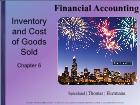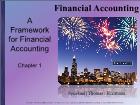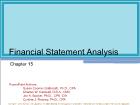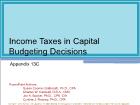TimTaiLieu.vn - Tài liệu, ebook, giáo trình, đồ án, luận văn
Tổng hợp tất cả tài liệu, ebook, giáo trình Khối Ngành Kinh Tế chọn lọc và hay nhất.

 Bài giảng Financial Accounting - Chapter 7: Long-Term Assets
Bài giảng Financial Accounting - Chapter 7: Long-Term AssetsLearning Objectives Identify the major types of property, plant, and equipment Identify the major types of intangible assets Describe the accounting treatment of expenditures after acquisition Calculate depreciation of property, plant, and equipment Calculate amortization of intangible assets Account for the disposal of long-term assets
 42 trang | Chia sẻ: nguyenlinh90 | Ngày: 19/07/2019 | Lượt xem: 1070 | Lượt tải: 0
42 trang | Chia sẻ: nguyenlinh90 | Ngày: 19/07/2019 | Lượt xem: 1070 | Lượt tải: 0 Bài giảng Financial Accounting - Chapter 6: Inventory and Cost of Goods Sold
Bài giảng Financial Accounting - Chapter 6: Inventory and Cost of Goods SoldLearning Objectives Trace the flow of inventory costs from manufacturing companies to merchandising companies Understand how cost of goods sold is reported in a multiple-step income statement Determine the cost of goods sold and ending inventory using different inventory cost methods Explain the financial statement effects and tax effects of in...
 35 trang | Chia sẻ: nguyenlinh90 | Ngày: 19/07/2019 | Lượt xem: 1139 | Lượt tải: 0
35 trang | Chia sẻ: nguyenlinh90 | Ngày: 19/07/2019 | Lượt xem: 1139 | Lượt tải: 0 Bài giảng Financial Accounting - Chapter 5: Receivables and Sales
Bài giảng Financial Accounting - Chapter 5: Receivables and SalesLearning Objectives Recognize accounts receivable Calculate net revenues using discounts, returns, and allowances Record an allowance for future uncollectible accounts Use the aging method to estimate future uncollectible accounts Apply the procedure to write off accounts receivable as uncollectible
 40 trang | Chia sẻ: nguyenlinh90 | Ngày: 19/07/2019 | Lượt xem: 970 | Lượt tải: 0
40 trang | Chia sẻ: nguyenlinh90 | Ngày: 19/07/2019 | Lượt xem: 970 | Lượt tải: 0 Bài giảng Financial Accounting - Chapter 4: Cash and Internal Controls
Bài giảng Financial Accounting - Chapter 4: Cash and Internal ControlsLearning Objectives Discuss the impact of accounting scandals and the passage of the Sarbanes-Oxley Act Identify the components, responsibilities, and limitations of internal control Define cash and cash equivalents Understand controls over cash receipts and cash disbursements Reconcile a bank statement
 35 trang | Chia sẻ: nguyenlinh90 | Ngày: 19/07/2019 | Lượt xem: 864 | Lượt tải: 0
35 trang | Chia sẻ: nguyenlinh90 | Ngày: 19/07/2019 | Lượt xem: 864 | Lượt tải: 0 Bài giảng Financial Accounting - Chapter 3: The Accounting Cycle: End of the Period
Bài giảng Financial Accounting - Chapter 3: The Accounting Cycle: End of the PeriodLearning Objectives Understand when revenues and expenses are recorded Distinguish between accrual-basis and cash-basis accounting Demonstrate the purposes and recording of adjusting entries Post adjusting entries and prepare an adjusted trial balance
 29 trang | Chia sẻ: nguyenlinh90 | Ngày: 19/07/2019 | Lượt xem: 954 | Lượt tải: 0
29 trang | Chia sẻ: nguyenlinh90 | Ngày: 19/07/2019 | Lượt xem: 954 | Lượt tải: 0 Bài giảng Financial Accounting - Chapter 2: The Accounting Cycle: During the Period
Bài giảng Financial Accounting - Chapter 2: The Accounting Cycle: During the PeriodLearning Objectives Identify the basic steps in measuring external transactions Analyze the impact of external transactions on the accounting equation Assess whether the impact of external transactions results in a debit or credit to an account balance Record transactions using debits and credits Post transactions to T-accounts in the general ...
 24 trang | Chia sẻ: nguyenlinh90 | Ngày: 19/07/2019 | Lượt xem: 928 | Lượt tải: 0
24 trang | Chia sẻ: nguyenlinh90 | Ngày: 19/07/2019 | Lượt xem: 928 | Lượt tải: 0 Bài giảng Financial Accounting - Chapter 1: A Framework for Financial Accounting
Bài giảng Financial Accounting - Chapter 1: A Framework for Financial AccountingLearning Objectives Describe the two primary functions of financial accounting Understand the business activities that financial accounting measures Determine how financial accounting information is communicated through financial statements Describe the role that financial accounting plays in the decision-making process
 33 trang | Chia sẻ: nguyenlinh90 | Ngày: 19/07/2019 | Lượt xem: 1163 | Lượt tải: 0
33 trang | Chia sẻ: nguyenlinh90 | Ngày: 19/07/2019 | Lượt xem: 1163 | Lượt tải: 0 Chapter 15: Financial Statement Analysis
Chapter 15: Financial Statement AnalysisDollar and Percentage Changes on Statements Horizontal analysis (or trend analysis) shows the changes between years in the financial data in both dollar and percentage form.
 57 trang | Chia sẻ: nguyenlinh90 | Ngày: 19/07/2019 | Lượt xem: 1123 | Lượt tải: 0
57 trang | Chia sẻ: nguyenlinh90 | Ngày: 19/07/2019 | Lượt xem: 1123 | Lượt tải: 0 Chapter 14: Statement of Cash Flows
Chapter 14: Statement of Cash FlowsThis principle ensures that properly analyzing the changes in all noncash balance sheet accounts always quantifies the cash inflows and outflows that explain the change in the cash balance.
 31 trang | Chia sẻ: nguyenlinh90 | Ngày: 19/07/2019 | Lượt xem: 1151 | Lượt tải: 0
31 trang | Chia sẻ: nguyenlinh90 | Ngày: 19/07/2019 | Lượt xem: 1151 | Lượt tải: 0 Appendix 13C: Income Taxes in Capital Budgeting Decisions
Appendix 13C: Income Taxes in Capital Budgeting DecisionsA capital budgeting project’s incremental net income computations include: Annual revenues. Annual cash operating expenses. Annual depreciation expense. One-time expenses related to repairs and maintenance.
 14 trang | Chia sẻ: nguyenlinh90 | Ngày: 19/07/2019 | Lượt xem: 1441 | Lượt tải: 0
14 trang | Chia sẻ: nguyenlinh90 | Ngày: 19/07/2019 | Lượt xem: 1441 | Lượt tải: 0
Website đang trong thời gian thử nghiệm, chờ xin giấy phép của Bộ TT & TT.

